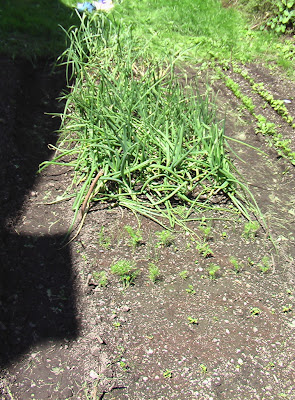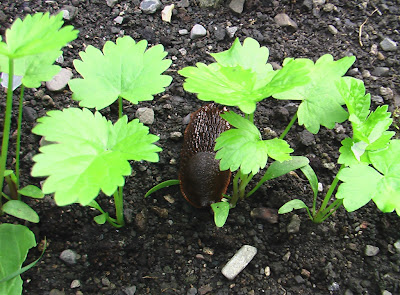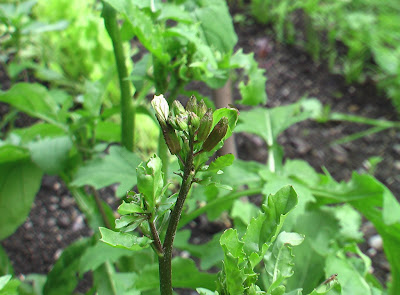Week 27 - Bed 12



A small educational garden in Dublin, Ireland



Posted by
Bruce Darrell
0
comments
![]()


Posted by
Bruce Darrell
0
comments
![]()

Posted by
Bruce Darrell
0
comments
![]()
We dug up all of the brassica transplants out of this bed and selected the healthiest plants for transplanting back into the bed at wider spacing, keeping in mind that the turnip will likely be harvested within the next few weeks.
 The weather conditions were damp, cool and overcast when we transplanted the young plants, but the sun came out shortly after and the plants stated to wilt because the disturbed roots could not suck up the amount of water that the plant needed. These plants will recover with a good watering and will be helped by the cool wet conditions that are forecast.
The weather conditions were damp, cool and overcast when we transplanted the young plants, but the sun came out shortly after and the plants stated to wilt because the disturbed roots could not suck up the amount of water that the plant needed. These plants will recover with a good watering and will be helped by the cool wet conditions that are forecast. We sowed significantly more brassica plants that we had space for, We could have sowed only a half row of each and still had enough. The remaining mix of brassica seedlings that we did not have space for were steamed for dinner!
We sowed significantly more brassica plants that we had space for, We could have sowed only a half row of each and still had enough. The remaining mix of brassica seedlings that we did not have space for were steamed for dinner!
Posted by
Bruce Darrell
0
comments
![]()


Posted by
Bruce Darrell
0
comments
![]()
We finally dug and prepared this bed as a deep lazy bed with extra sod from the paths chopped up under the soil. This bed is slightly smaller than the others because of some large slate slabs at one end. In the prepared seedbed, we planted two winter storage roots from the brassica family:

Posted by
Bruce Darrell
0
comments
![]()


Posted by
Bruce Darrell
0
comments
![]()




Posted by
Bruce Darrell
1 comments
![]()


Posted by
Bruce Darrell
1 comments
![]()
In the empty space at the north end of the bed (far end in the photograph below) we planted:
 Bean seedlings can be seen at the base of some of the bamboo poles.
Bean seedlings can be seen at the base of some of the bamboo poles. A healthy climbing french bean seedling, one of only a few.
A healthy climbing french bean seedling, one of only a few.
Posted by
Bruce Darrell
0
comments
![]()




Posted by
Bruce Darrell
0
comments
![]()


Posted by
Bruce Darrell
0
comments
![]()

 This map of Ireland from the Met Éireann web site shows the amount of rainfall for the past week as a percentage of what we would normally expect (the garden is located in Dublin at the middle of the east coast - close to the 416% figure). It has been a very rainy period with only 1/3 of the sunshine that we would normally expect.
This map of Ireland from the Met Éireann web site shows the amount of rainfall for the past week as a percentage of what we would normally expect (the garden is located in Dublin at the middle of the east coast - close to the 416% figure). It has been a very rainy period with only 1/3 of the sunshine that we would normally expect. This diagram show how much rainfall would be needed to provide the soil with as much water as it could hold (without draining excess away). With a figure of 2mm, any more rain will start to saturate the soil, affecting plant growth. Luckily there is better weather on the way - though not great for this time of year.
This diagram show how much rainfall would be needed to provide the soil with as much water as it could hold (without draining excess away). With a figure of 2mm, any more rain will start to saturate the soil, affecting plant growth. Luckily there is better weather on the way - though not great for this time of year.
Posted by
Bruce Darrell
0
comments
![]()




Posted by
Bruce Darrell
0
comments
![]()

Posted by
Bruce Darrell
0
comments
![]()

Posted by
Bruce Darrell
0
comments
![]()


Posted by
Bruce Darrell
0
comments
![]()
We decided to give up on the beetroot and chard, and cleared them from the bed - besides we needed the space for the brassica transplants that are getting too big in Bed 9. We mixed in a few handfuls of dried seaweed fertilizer and transplanted 4 types of cabbages (listed from south to north):
 View from the north end of the bed showing the 12 cabbage transplants, with the peas at the south end of the bed.
View from the north end of the bed showing the 12 cabbage transplants, with the peas at the south end of the bed.
Posted by
Bruce Darrell
0
comments
![]()



Posted by
Bruce Darrell
0
comments
![]()

Posted by
Bruce Darrell
0
comments
![]()



Posted by
Bruce Darrell
0
comments
![]()
